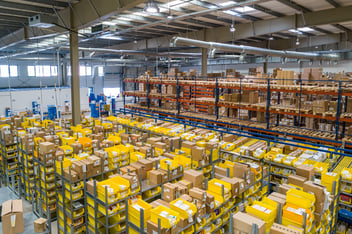Simplifying Your SME’s Logistics with the Right Logistics Solution
Delivering your products from point A to Ziing seems like a pretty straightforward task.
And it actually is.
Until you realize it’s not.
As your business scales, delivery becomes a multi-process and complex suite. Taking each item to a post office is no more viable, and that's when you need logistics services.
Logistics solutions take over all the operations linked with 'logistics' from your business, including the overall management of the shipment process, dispatching the right order, and the delivery of each item so products end up at the right destination at the right time.
Let's dive into logistics services and what it means to work with a 3PL. We’ll discuss how the right logistics solution can help you simplify your supply chain and empower your business.
What Are Logistics Services?
According to Investopedia, logistics management is the overall process of managing how resources are acquired, stored, and transported to their final destination. Logistics services include identifying prospective distributors and suppliers as well as making sure to build cohesive partnerships with them.
The term 'logistics' has its roots in the military in reference to how military personnel used to obtain, store, and move equipment and supplies. It’s a widely used term in the business world today and particularly in the manufacturing industry, where it indicates how goods move across the supply chain.
If done well, logistics services handle the overall supply chain management smoothly.
If not done well, it directly affects the bottom line of business and leads to unsatisfied customers, the last thing anyone wants.
The Process
Each logistics company has its own unique process, but as a default, here's what the process includes:
- Delivery and transportation of goods from the manufacturing unit (factory) to the fulfillment warehouse.
- Managing the warehouse and fulfilling orders.
- Planning shipping routes, managing the fleet, and the final delivery to the customer's doorstep.
The Levels of Logistics Services - 1 PL to 5 PL
The industry only started as a need to 'move' goods and now is continuously expanding on multiple levels to provide specific solutions at each stage of business.
Currently, the most common levels in logistics services are 1PL to 5PL, but the entire range is 1PL to 10PL. Here's how they differentiate:
First-party Logistics (1PL)
First-party logistics occurs when a manufacturer handles its own shipping and warehousing needs. 1PL companies manage their own fleet and distribute goods to their own distribution centers or retail shops as needed.
Second-party Logistics (2PL)
Second-party logistics occurs when a manufacturer only outsources the shipping aspect of their business since it's very costly to manage an entire fleet of trucks in-house. Some prime examples of 2PL businesses are UPS and FedEx–two shipping businesses largely famous for 'shipping' the products only.
Third-party Logistics (3PL)
Third-party logistics is much more complex than 1PL and 2PL. It’s when the manufacturer only focuses on producing and selling the product and 3PL logistics services take care of everything else, keeping the supply chains running smoothly. This is where 'outsourcing logistics' comes into play.
One example of 3PL is Amazon. E-commerce sellers produce or procure items, and Amazon takes care of everything else, including shipping, warehousing, and reverse logistics.
While Amazon 3PL is the base model for most 3PL companies, some logistics providers also offer services like Just-in-time (JIT) delivery and assembly.
Fourth-party Logistics (4PL)
4PL is a step further from 3PL, where businesses stop managing their supply chain and distribution. This may seem like giving up a lot of control to a logistics company, but in reality, it gives a lot of benefits, especially at a scale where you don't have to hire or train supply chain managers at all.
4PL acts as your business partner more than a vendor. They constantly run analysis and keep you up to date when your inventory is running low, and also partner with better distributors to negotiate a better contract. 4PL logistics companies also pool resources from multiple other partners to give you the best of both worlds.
Fifth-party logistics (5PL)
5PL is the most advanced layer right now and is only a good fit for some technology niche businesses. 5PL logistics providers use robotics, blockchain, artificial intelligence, and big data to leverage technology and drive efficiency across your supply chain.
How to Choose the Right Level for your Business
This choice depends on a variety of factors. While 1PL and 2PL may seem like the most viable options when you’re starting a business, it becomes a headache to manage a fleet and warehousing on your own as you scale.
5PL, on the other hand, targets very specific technology-first businesses. So 3PL and 4PL seem to be a great fit for most businesses.
According to a report by Armstrong & Associates, In 2019, nearly 90% of Fortune 500 companies were using third-party logistics providers (3PLs) for logistics and supply chain functions.
So for businesses that want to lower the costs of supply chains without shifting the costs onto the consumer, hiring a third-party logistics service is a good business decision.
3 Key Functions of a Third-Party Logistics Company
3PL logistics company tends to focus on discrete functions of supply chain management. Here are three main functions of a third-party logistics service:
Transportation Services
As a key function, all 3PL providers can manage transportation for your business, consolidate less than container load (LCL) or less than truckload (LTL) freight, track orders, manage routes, collect freight payments and also manage consolidated or dedicated fleets.
Global Shipping
Shipping to customers worldwide can be one of the most important perks of working with third-party logistics providers. Dealing with customs and freight forwarding can be very challenging for small and medium businesses, and working with a 3PL can take that stress away.
Reverse Logistics and Returns
Just as shipping the products is important, reverse logistics or returns are equally important for businesses to save costs and track their customer feedback. 3PL companies can reclaim packages and manage the overall reverse logistics for the pickups of products returned by customers.
How a Logistics Services Provider Can Simplify the Process
Low cost and no headache are two main reasons why businesses opt for third-party logistics services, but there are more benefits than just saving costs. Here are some of them:
Scale Faster
This is probably the most important benefit of using a third-party logistics service. Having a 3PL shipping provider means the company can scale in terms of regions, labor, and fleet while managing its inventory.
Entering into new regions and not having to deal with building an entire fleet for your business can aid in faster growth and a highly optimized and efficient supply chain.
Time, Cost, and Talent
Working with 3PL services doesn’t only allow you to expand and scale faster but it also frees up your time and saves up a huge amount of costs.
As a business, you won't need to worry about investing in warehouse space, building your own fleet, transportation management, and hiring human resources to carry out logistics processes.
This allows you to put more focus on your core products and outsource the operations that aren’t your core competencies.
Compliance and Regulations
With 3PL, your global shipments are well taken care of without having to deal with regulations and compliance at your end. 3PL companies have insight into regulations and customs concerns that are prevalent when shipping internationally.
Resourceful Insights and Continuous Optimization
By working with a 3PL company, your supply chain management improves tremendously. You receive resourceful insights on when to procure your products and ensure that goods arrive on time. Many 3PL companies also use software to continuously optimize the delivery process for their clients.
Finding the Right Solution for Your Business
Choosing the right logistics service provider depends on your business needs, goals, and growth predictions. At any stage, you’ll come across thousands of logistics service providers offering the same range of services.
So how do you find the best among the rest? Here are some indicators to look for when choosing a logistics service for your business.
Evaluate Your Needs
Have a sit down with your team and draft a document that highlights your current volume, requirements in overall supply chain management, and the results expected from the engagement. Evaluate what type of logistics company is a good fit for you in light of how fast or slow the company plans to expand or scale in the near future.
Always choose a company that can easily handle your current logistics needs but is also capable of expanding or scaling with you as your shipment volume increases.
Decide Your Engagement Level
For each company, the engagement level looks different. A logistics service impacts all departments within the organization and works at all levels.
Having an understanding and vote of confidence from all stakeholders is important and will reduce the chance of any hiccups.
Look For Flexibility
Organizations that offer solutions in multiple segments and are ready to switch gears as you scale are better to work with than an organization that is set in its own ways.
The one-size-fits-all method of doing business is no longer valid for many industries. If the provider doesn't understand this, they may not be a good fit for you.
Review 'End-User' Feedback
Look up the company's portfolio and ask for client references. As much as the existing client feedback on their sales pitch is valuable, it doesn't always reflect the ground realities.
Speak to the end-user about their services. For example, if you know the logistics service works with a particular client, read their end-users reviews on deliveries and overall customer satisfaction.
Always pay attention to their ratio of on-time versus delayed deliveries, how they handle returns, and how they communicate with their customers.
Keep Sustainability in Mind
According to a new study, by 2050, shipping will be responsible for 17%of global CO2 emissions.
Companies are now taking drastic measures to combat the damage that's already been done by committing to zero carbon shipping or becoming carbon neutral in their operations.
Always look for logistics services that have sustainability as one of their strategic initiatives. The world is purpose-driven, and if you make the mistake of working with a partner that doesn't care about the environment, you may not only lose your customers but also choose to play an active role in damaging the planet.
Empower Your SME
At Ziing, we foster sustainability in the logistics industry with our partnerships and services. We’re building an ecosystem with a national network of knowledgeable, verified local companies and a team that works around the clock to offer the delivery service you’ve been searching for.
Are you looking to:
- Identify the most cost-effective routing and delivery schedule for your business?
- Blend dedicated services and distribution services to fit your business needs?
Reach out to us, and let's explore how our sustainable logistics solutions can empower your business.






